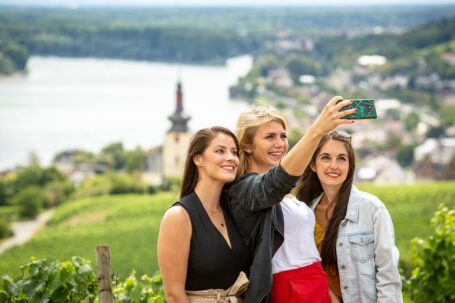Germany’s Wine Regions are Holiday Gems for Czechs

Germany is an increasingly popular travel destination for Czechs. In the decade before the pandemic (2009-2019), multi-night visits by Czechs to Germany increased by 130%, and in 2019, the number of overnight stays was the highest ever, at almost 1.4 million. Last year, Germany was Czechs’ second-favourite travel destination behind Austria, and the latest data shows that so-called “wine tourism” forms a significant part of Germany’s growing travel appeal.
The Growing Appeal of Wine Tourism
The most popular destinations within Germany suggest that preference for the wine regions has already taken root. Bavaria, Saxony and Baden-Wurttemberg were the top three regions visited by Czechs in 2020, and all feature regions for high-quality wine. Wine tourism is increasingly important for German wine-makers – a report produced by the German Wine Institute and Hochschule Geisenheim University showed that 85% of wine producers in Germany’s wine regions are active in wine tourism.
Of this number, 62% cited growing numbers of tourists, and 61% claimed their wine tourism activities would increase in the coming years. Popular wine activities include tastings and guided tours, offered by 85% of wineries active in wine tourism. Wine tourism accounts for a growing portion of these companies’ revenues: around a quarter, on average, but going up to 34% for small wineries of less than seven hectares. Wine tourists contribute significantly to local economies: out of a combined tourism revenue of around 30 billion euros in the wine regions, around a third comes from wine tourists.
Exploring the beauty of Germany on the German Wine Route
The most scenic way to explore Germany’s wine regions is on the country’s famous wine routes. The oldest wine route, covering 85 km in the Palatinate-Rhineland region, is one of the oldest tourist routes in Germany, taking travellers from the House of the German Wine Route in Bockenheim, on the outskirts of Rheinhessen, to the German Wine Gate in Schweigen-Rechtenbach on the French border.
Medieval villages and towns such as Neuleiningen and Freinsheim are dotted along the route, and at the heart of the Pfalz region, travellers can enjoy fine wines, explore wine estates, and sample renowned local gastronomy in rustic taverns and Michelin-starred restaurants. There are also important historical places to visit, including the UNESCO world heritage site Speyer Cathedral, and Hambacher Schloss, the cradle of German democracy since the Hambacher Fest of 1832.
Travellers can explore the German Wine Routes by foot, by bike, or by car, taking in some of the most remarkable places on the map of the German wine industry. In Bad Dürkheim, travellers can find the world’s biggest wine barrel, which houses a restaurant, and its biggest wine festival all in one place. Travellers can explore Höhepunkt der Weinkultur, the oldest vineyard in the world, and they can visit the location for the election of Germany’s famous “Wine Queen” at Neustadt.
The German Wine Route offers some of the best hiking trails in the country too. Neustadt is a great place to kick off a hiking adventure through the vineyards and forests of the Pfälzer Wald, while the Pfälzer Weinsteig, one of Germany’s most renowned hiking paths, runs parallel to the wine route and takes in vineyards, orchards and forests.
“Exploring the German Wine Routes is one of the best ways to really experience German culture,” says Steffen Schindler, Director of Marketing at the German Wine Institute. “Not only this, but travellers also get the opportunity to experience wines from some of the country’s oldest and most renowned vineyards. The length and variety of the routes allows so much choice: you can hop from one vineyard to the next, exploring all that German wines have to offer; or you can simply enjoy a glass of wine or two as a refreshing break from your outdoor and cultural adventures. And the best part: people in Pfalz are well-known for being extremely friendly and hospitable!”
The perfect post-pandemic holiday
According to Jan Pohaněl, Director for the Czech Republic at the German National Tourist Board, Germany’s Wine Regions are an ideal opportunity for Czechs looking to kick their post-pandemic travels off with safe, outdoor activities accessible by car.
“Lots of visitors prefer to travel by car from the Czech Republic to Germany, and the pandemic has accelerated this trend,” he says. “It is also likely that, following the pandemic, more holidaymakers will be interested in trips to nature. For Czechs keen to go on holiday by car, to destinations with stunning natural scenery, the German Wine Regions certainly have a lot to offer.”
On the other hand, it shouldn’t be forgotten that the fruits of the German wine regions can also be experienced as part of a German city break. Whether in Berlin, Munich, Dresden, Hamburg, Cologne, or any of Czechs’ other favourite urban spots, travellers can enjoy Germany’s renowned Riesling, Sekt, Rosé, Pinot Noir, and more at some of the world’s most exciting wine bars and restaurants. Wherever you travel in Germany, mixing wine with tourism makes for an unforgettable experience.